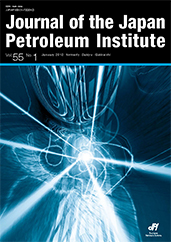Volume 55, Issue 3
Displaying 1-10 of 10 articles from this issue
- |<
- <
- 1
- >
- >|
Review Papers
-
Article type: Review Paper
2012 Volume 55 Issue 3 Pages 149-159
Published: 2012
Released on J-STAGE: July 01, 2012
Download PDF (1178K) -
Article type: Review Paper
2012 Volume 55 Issue 3 Pages 160-170
Published: 2012
Released on J-STAGE: July 01, 2012
Download PDF (1655K) -
Article type: Review Paper
2012 Volume 55 Issue 3 Pages 171-181
Published: 2012
Released on J-STAGE: July 01, 2012
Download PDF (1151K)
Regular Papers
-
Article type: Regular Paper
2012 Volume 55 Issue 3 Pages 182-190
Published: 2012
Released on J-STAGE: July 01, 2012
Download PDF (651K) -
Article type: Regular Paper
2012 Volume 55 Issue 3 Pages 191-196
Published: 2012
Released on J-STAGE: July 01, 2012
Download PDF (272K) -
Article type: Regular Paper
2012 Volume 55 Issue 3 Pages 197-205
Published: 2012
Released on J-STAGE: July 01, 2012
Download PDF (1141K) -
Article type: Regular Paper
2012 Volume 55 Issue 3 Pages 206-213
Published: 2012
Released on J-STAGE: July 01, 2012
Download PDF (413K)
Readers’ Comments
-
Article type: Readers' Comments
2012 Volume 55 Issue 3 Pages 214
Published: 2012
Released on J-STAGE: July 01, 2012
Download PDF (119K) -
Article type: Readers' Comments
2012 Volume 55 Issue 3 Pages 214
Published: 2012
Released on J-STAGE: July 01, 2012
Download PDF (119K)
Letter
-
Article type: Letter
2012 Volume 55 Issue 3 Pages 215-218
Published: 2012
Released on J-STAGE: July 01, 2012
Download PDF (1333K)
- |<
- <
- 1
- >
- >|
